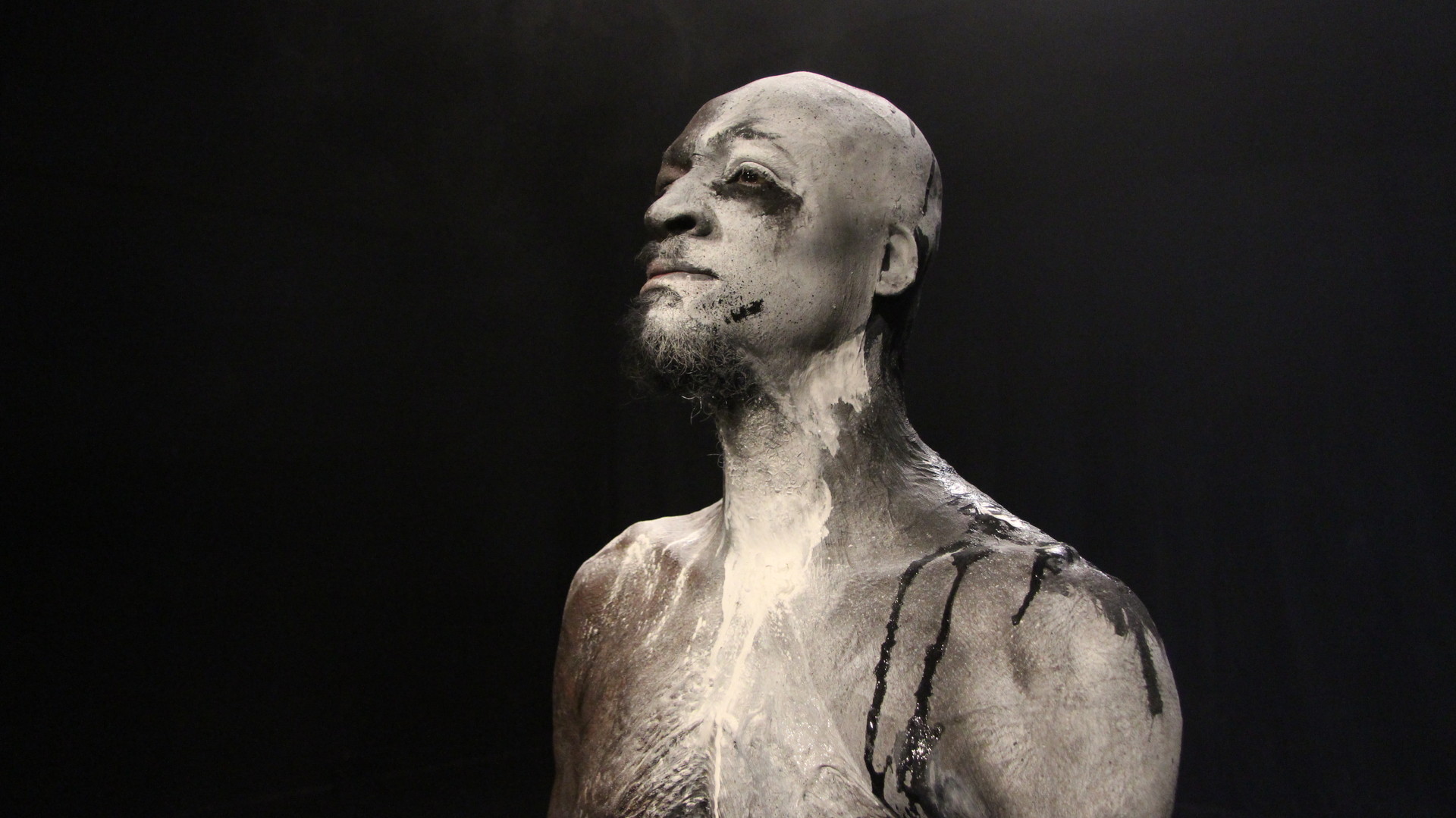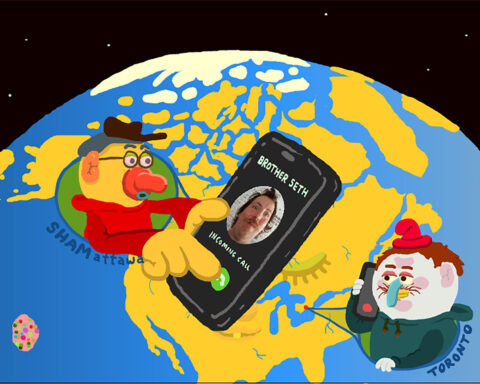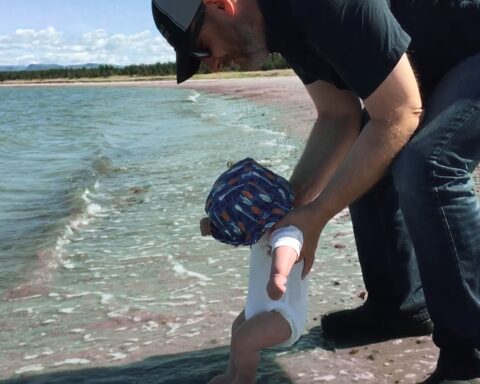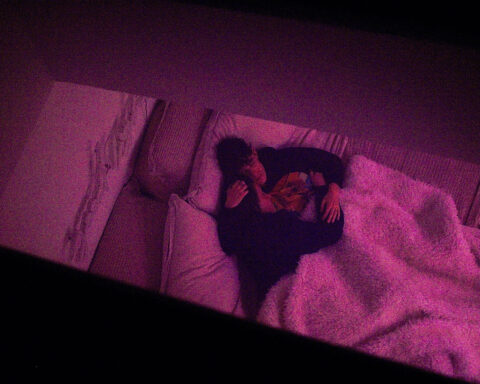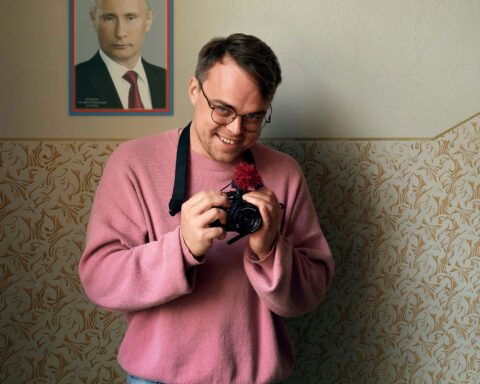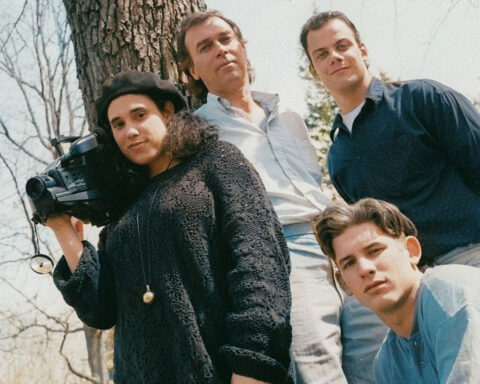Jamie Miller’s Prince’s Tale, Sophy Romvari’s duo Norman Norman and Pumpkin Movie, and Sofia Bohdanowicz’s Veslemøy’s Song highlight some of the newer voices in Canadian documentary. The films are loosely connected by themes of mortality, history, legacy, and memory, but they share a greater connection in illustrating the originality of vision that can arise when a new generation of talent steps behind the camera. They’re artfully valuable reminders of the need for more inclusive representation both onscreen and off.
Prince’s Tale
dir. Jamie Miller
Jamie Miller’s Prince’s Tale caught Hot Docs by storm this spring when it dethroned Morgan Neville’s Won’t You Be My Neighbor? in the audience award rankings. The uplifting film won the jury prize for best Canadian short doc and the audience award for top short. Miller’s film is a portrait of Toronto-based actor Prince Amponsah, telling the story of how Amponsah returned to acting after surviving an apartment fire in which he lost both of his forearms. He is now nearly 70% scarred. The Newfoundland-born Miller, a graduate of York University’s film program, says she discovered Amponsah’s tale through friends who lived in the same building. She encountered his spirit when she saw him in a play.
“I met him after the play for a short chat,” says Miller. “I asked him then and there [about making a documentary about him] without really thinking about it. It was a cold ask—it was terrifying.” Miller tells the darker side of Amponsah’s story while highlighting his strength as a performer as he takes to the stage in a captivating dance. The film cuts fleetingly between images of the city while audio interviews bridge the visuals. Miller lets Amponsah’s talent be the guiding light in their collaboration.
“I met him after the play for a short chat,” says Miller. “I asked him then and there [about making a documentary about him] without really thinking about it. It was a cold ask—it was terrifying.” Miller tells the darker side of Amponsah’s story while highlighting his strength as a performer as he takes to the stage in a captivating dance. The film cuts fleetingly between images of the city while audio interviews bridge the visuals. Miller lets Amponsah’s talent be the guiding light in their collaboration.
“He brought the dance to the table and we didn’t have much rehearsal time, so we really didn’t know how the movements were going to cover the stage,” explains Miller. The film focuses on Amponsah’s present and future, rather than his past, as it empowers him as an artist. The camera dances fluidly with Prince as theatrical lighting and dusty white make-up accentuate his stage presence. “Prince said it reminded him of a statue coming to life,” adds Miller. “I love that concept for the relationship with the body and the movements and image. It was really evocative.”
If Amponsah’s dance evokes comparison to a Venus de Milo figure, it’s a testament to the film’s contribution to positive representation. Miller says audiences are eager to learn more of Amponsah’s career, which includes plays, television, and shorts films. “He connects with people on how to think about identity and trauma,” she notes. “He’s such a positive representation of how to be yourself even if you’ve gone through the worst.”
Miller hopes the film will contribute to further discussion on representation for diverse artists. “I’m hoping the more that Prince comes with me to festivals, he’ll be able to increase that dialogue,” she says.
Prince’s Tale is primed to put this conversation in the spotlight. Winning the Hot Docs jury prize makes the film eligible for Best Documentary (Short Subject) at the Oscars, where even just making the shortlist would give Amponsah’s story a global stage. Miller, who’s essentially running a one-woman campaign, says she’s talked to a few people on how to approach the Oscar race, which is a different beast for the branch-specific shorts. For now, she is simply enjoying the moment as she expands the film’s reach. “In the end, people are just drawn to Prince,” she says. “It’s just been such a positive experience with him.”
Norman Norman and Pumpkin Movie
dir. Sophy Romvari
Mortality receives an unexpectedly droll exploration in Sophy Romvari’s Norman Norman, which debuts at TIFF this fall. The film observes Romvari’s 17-year-old dog Norman as he lies at her feet while she watches news coverage about Barbra Streisand cloning her dog. Romvari says she conceived the film after friends sent her an article about Streisand’s indulgence. (At this point in the interview, Norman chimes in from the background, but unfortunately, the transcription software couldn’t interpret his answers.)
Romvari says Norman Norman began as a mix of fiction and research-based documentary, since she had planned to interview veterinarians. “It turned out that the research was the film,” she explains.
Romvari processes her feelings remarkably in a doc she shot over two days while her previous film, Pumpkin Movie, was at Hot Docs this spring. Pumpkin Movie, like Norman Norman, is a hybrid of sorts, as Romvari puts herself before the camera to exchange stories of sexual harassment during a pumpkin-carving Skype date with her friend Leah. The film, which Romvari shot in an hour while at VIFF with her previous movie, began as part of a horror anthology. “I asked myself, ‘What is the scariest thing that I can think of right now?’ and very quickly I realized it was men!” Romvari laughs.
While documentary festivals like Hot Docs and True/False have programmed Pumpkin Movie, Romvari finds the classification intriguing. “People think it’s a documentary, but it’s absolutely a fiction as far as I’m concerned,” says Romvari. “It’s shot in a hybrid method in that we’re non-actors reacting to one another in an unplanned situation.”
Perhaps the documentary element resides in the stories. Pumpkin Movie draws upon accounts of sexual harassment experienced by Romvari, her co-star, and nearly 50 people sourced via Twitter. The final title card of Pumpkin Movie thanks the many contributors who came forward for the film. The impactful punctuation mark reminds audiences that the pumpkin carvers are simply two voices among many.
Romvari adds that Pumpkin Movie was in the works before the #MeToo movement exploded. She tweeted her call for stories on October 6, one day after The New York Times reported Harvey Weinstein’s sexual predation and nine days before actress Alyssa Milano amplified #MeToo on Twitter. “I went through a difficult process trying not to feel like I was capitalizing on a movement, but still wanting to be part of the conversation,” says Romvari. “#MeToo is not the beginning of feminism. Those things were already happening.”
Pumpkin Movie furthers the conversation by reminding audiences that sharing these stories can be powerful. “If you don’t tell these stories and if you don’t write them down, you forget them because they happen so often,” Romvari says.
Veslemøy’s Song
dir. Sofia Bohdanowicz
Sofia Bohdanowicz seems like a festival veteran after several shorts and the features Never Eat Alone (2016) and Maison du Bonheur (2017), so admirers of her work and other film buffs must not miss Veslemøy’s Song. It’s Bohdanowicz’s best film yet. This playfully curious docu-fiction lands at TIFF after Locarno. It highlights a unique talent.
Veslemøy’s Song explores a slice of Bohdanowicz’s family history after her uncle Steve Benac gave her a book about the violinist Kathleen Parlow, a mentor to Bohdanowicz’s late grandfather. “When I made Never Eat Alone, which featured my grandmother’s history, it brought their past back to life,” explains Bohdanowicz. “I think my uncle seeks to see a bit of my grandfather brought to life, but he’s also interested in re-establishing Kathleen Parlow as an important Canadian figure. She’s kind of been forgotten.”
Veslemøy’s Song sees Audrey Benac, played by Bohdanowicz collaborator Deragh Campbell, visit the New York Public Library (NYPL) to hear a rare recording of Parlow’s music. Audrey is humorously cheated by library protocol when Parlow’s performance of Johan Halvorsen’s “Veslemøy’s Song” is cut short mid-song. The unseen librarian informs her via computer that the recording is too fragile to play in full.
“Veslemøy’s Song is an exaggerated account of what happened,” says Bohdanowicz, recalling that she visited the NYPL to hear Parlow’s music and noted details of her experience. Audio interviews and Bolex footage of her relatives add to the playful exploration of form. “It always starts from reality and I twist it into fiction,” says Bohdanowicz.
Campbell narrates the film and plays Bohdanowicz’s fictional counterpart. The director first perceived Campbell’s dramatic presence while observing her at a cheese club they both attended with friends. “When I have an idea for someone to play in one of my films, I’ll sneakily watch them or find situations where I can spend time with them,” says Bohdanowicz.
The film embellishes Bohdanowicz’s experience with the recording for comedic effect, but it also takes seriously the sensation of being denied a chance to appreciate history. “I really wanted to study it and feel close to the material,” adds Bohdanowicz. “It got me thinking about how if you don’t take care of someone’s history, it can disintegrate.”
Bohdanowicz’s curiosity frequently invites comparison to legendary filmmaker Agnès Varda. She humbly accepts the appraisal. “She’s paved the way for filmmakers to do the work that I make, because there’s now a reference for the visual language,” says Bohdanowicz. “When I watch her work or [Chantal] Akerman’s work, I feel they’ve made space for me as an artist.”
The impact of trailblazers like Varda is evident in this new generation of filmmakers. “What I learned from Varda’s filmmaking is that you can take simple ideas and bring them to life,” says Bohdanowicz. “In watching her filmmaking, I learned that you can make a film if you’re curious, if you’re economical, and if you’re authentic.”




